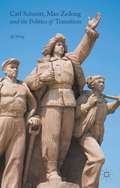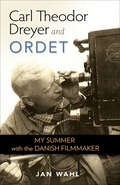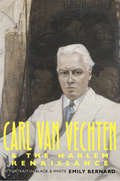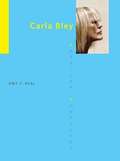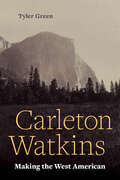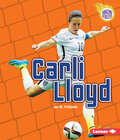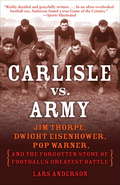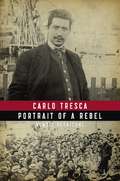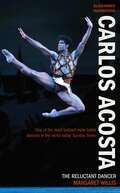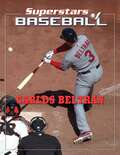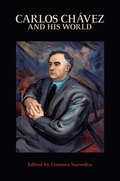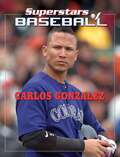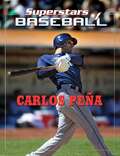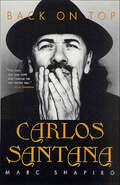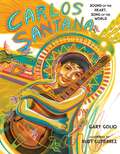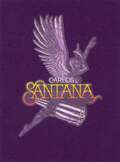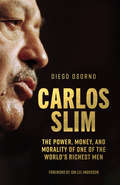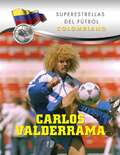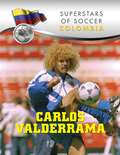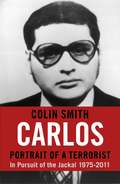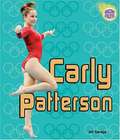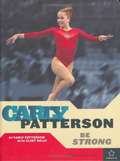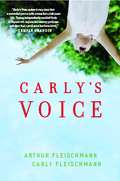- Table View
- List View
Carl Schmitt, Mao Zedong and the Politics of Transition
by Qi ZhengThis book develops a new way of reading and benefiting from Schmitt's legal and political theories. It explores Schmitt's theories from the perspective of what I refer to as the politics of transition. It also contributes to identifying the real theoretical relationship between Schmitt and Mao.
Carl Theodor Dreyer and Ordet: My Summer with the Danish Filmmaker (Screen Classics)
by Jan WahlThis illustrated memoir shares a rare inside look at the legendary director’s process and vision during the filming of his award-winning masterpiece.Danish director Carl Theodor Dreyer is considered one of the most influential filmmakers in cinematic history. His 1955 film Ordet (The World) won numerous prizes, including the Venice Film Festival’s Golden Lion. In 1954, Dreyer invited young film student Jan Wahl to accompany him during this classic work.This captivating account of Wahl's time with the director is based on Wahl's daily journal and transcriptions of his conversations with Dreyer. Offering a glimpse into the filmmaker's world, Wahl fashions a portrait of Dreyer as a man, mentor, friend, and director. Wahl's detailed account is supplemented by exquisite photos of the filming and by selections from Dreyer's papers, including his notes on film style, his introduction for the actors before the filming of Ordet, and a visionary lecture he delivered at Edinburgh.
Carl Van Vechten and the Harlem Renaissance
by Emily BernardCarl Van Vechten was a white man with a passion for blackness who played a crucial role in helping the Harlem Renaissance, a black movement, come to understand itself. Carl Van Vechten and the Harlem Renaissanceis grounded in the dramas occasioned by the Harlem Renaissance, as it is called today, or New Negro Renaissance, as it was called in the 1920s, when it first came into being. Emily Bernard focuses on writing—the black and white of things—the articles, fiction, essays, and letters that Carl Van Vechten wrote to black people and about black culture, and the writing of the black people who wrote to and about him. Above all, she is interested in the interpersonal exchanges that inspired the writing, which are ultimately far more significant than the public records would suggest. This book is a partial biography of a once controversial figure. It is not a comprehensive history of an entire life, but rather a chronicle of one of his lives, his black life, which began in his boyhood and thrived until his death. The narrative at the core ofCarl Van Vechten and the Harlem Renaissanceis not an attempt to answer the question of whether Van Vechten was good or bad for black people, or whether or not he hurt or helped black creative expression during the Harlem Renaissance. As Bernard writes, the book instead “enlarges that question into something much richer and more nuanced: a tale about the messy realities of race, and the complicated tangle of black and white. ”
Carla Bley
by Amy C. BealThis is the first comprehensive treatment of the remarkable music and influence of Carla Bley, a highly innovative American jazz composer, pianist, organist, band leader, and activist. With fastidious attention to Bley's diverse compositions over the last fifty years spanning critical moments in jazz and experimental music history, Amy C. Beal tenders a long-overdue representation of a major figure in American music. Best known for her jazz opera "Escalator over the Hill," her role in the Free Jazz movement of the 1960s, and her collaborations with artists such as Jack Bruce, Don Cherry, Robert Wyatt, and Pink Floyd drummer Nick Mason, Bley has successfully maneuvered the field of jazz from highly accessible, tradition-based contexts to commercially unviable, avant-garde works. Beal details the staggering variety in Bley's work as well as her use of parody, quotations, and contradictions, examining the vocabulary Bley has developed throughout her career and highlighting the compositional and cultural significance of her experimentalism. Beal also points to Bley's professional and managerial work as a pioneer in the development of artist-owned record labels, the cofounder and manager of WATT Records, and the cofounder of New Music Distribution Service. Showing her to be not just an artist but an activist who has maintained musical independence and professional control amid the profit-driven, corporation-dominated world of commercial jazz, Beal's straightforward discussion of Bley's life and career will stimulate deeper examinations of her work.
Carleton Watkins: Making the West American
by Tyler Green"[A] fascinating and indispensable book."—Christopher Knight, Los Angeles TimesBest Books of 2018—The Guardian Gold Medal for Contribution to Publishing, 2019 California Book Awards Carleton Watkins (1829–1916) is widely considered the greatest American photographer of the nineteenth century and arguably the most influential artist of his era. He is best known for his pictures of Yosemite Valley and the nearby Mariposa Grove of giant sequoias. Watkins made his first trip to Yosemite Valley and Mariposa Grove in 1861 just as the Civil War was beginning. His photographs of Yosemite were exhibited in New York for the first time in 1862, as news of the Union’s disastrous defeat at Fredericksburg was landing in newspapers and while the Matthew Brady Studio’s horrific photographs of Antietam were on view. Watkins’s work tied the West to Northern cultural traditions and played a key role in pledging the once-wavering West to Union. Motivated by Watkins’s pictures, Congress would pass legislation, signed by Abraham Lincoln, that preserved Yosemite as the prototypical "national park," the first such act of landscape preservation in the world. Carleton Watkins: Making the West American includes the first history of the birth of the national park concept since pioneering environmental historian Hans Huth’s landmark 1948 "Yosemite: The Story of an Idea." Watkins’s photographs helped shape America’s idea of the West, and helped make the West a full participant in the nation. His pictures of California, Oregon, and Nevada, as well as modern-day Washington, Utah, and Arizona, not only introduced entire landscapes to America but were important to the development of American business, finance, agriculture, government policy, and science. Watkins’s clients, customers, and friends were a veritable "who’s who" of America’s Gilded Age, and his connections with notable figures such as Collis P. Huntington, John and Jessie Benton Frémont, Eadweard Muybridge, Frederick Billings, John Muir, Albert Bierstadt, and Asa Gray reveal how the Gilded Age helped make today’s America. Drawing on recent scholarship and fresh archival discoveries, Tyler Green reveals how an artist didn’t just reflect his time, but acted as an agent of influence. This telling of Watkins’s story will fascinate anyone interested in American history; the West; and how art and artists impacted the development of American ideas, industry, landscape, conservation, and politics.
Carli Lloyd (Amazing Athletes Ser.)
by Jon M FishmanSoccer hero Carli Lloyd knows how to score goals when her team needs them the most. She is one of the top players on the United States Women's National Team (USWNT). At the 2008 Olympic Games in Beijing, China, Carli scored the winning goal to give the USWNT the gold medal. Then, in 2012, she scored the gold medal game-winner again at the Olympic Games in London, England. In 2015, Carli scored three goals in the World Cup championship game to help her team take the title. Read all about her journey to the top.
Carlisle vs. Army: Jim Thorpe, Dwight Eisenhower, Pop Warner, and the Forgotten Story of Football's Greatest Battle
by Lars AndersonA stunning work of narrative nonfiction, Carlisle vs. Army recounts the fateful 1912 gridiron clash that pitted one of America's finest athletes, Jim Thorpe, against the man who would become one of the nation's greatest heroes, Dwight D. Eisenhower. But beyond telling the tale of this momentous event, Lars Anderson also reveals the broader social and historical context of the match, lending it his unique perspectives on sports and culture at the dawn of the twentieth century. This story begins with the infamous massacre of the Sioux at Wounded Knee, in 1890, then moves to rural Pennsylvania and the Carlisle Indian School, an institution designed to "elevate" Indians by uprooting their youths and immersing them in the white man's ways. Foremost among those ways was the burgeoning sport of football. In 1903 came the man who would mold the Carlisle Indians into a juggernaut: Glenn "Pop" Warner, the son of a former Union Army captain. Guided by Warner, a tireless innovator and skilled manager, the Carlisle eleven barnstormed the country, using superior team speed, disciplined play, and tactical mastery to humiliate such traditional powerhouses as Harvard, Yale, Michigan, and Wisconsin-and to, along the way, lay waste American prejudices against Indians. When a troubled young Sac and Fox Indian from Oklahoma named Jim Thorpe arrived at Carlisle, Warner sensed that he was in the presence of greatness. While still in his teens, Thorpe dazzled his opponents and gained fans across the nation. In 1912 the coach and the Carlisle team could feel the national championship within their grasp. Among the obstacles in Carlisle's path to dominance were the Cadets of Army, led by a hardnosed Kansan back named Dwight Eisenhower. In Thorpe, Eisenhower saw a legitimate target; knocking the Carlisle great out of the game would bring glory both to the Cadets and to Eisenhower. The symbolism of this matchup was lost on neither Carlisle's footballers nor on Indians across the country who followed their exploits. Less than a quarter century after Wounded Knee, the Indians would confront, on the playing field, an emblem of the very institution that had slaughtered their ancestors on the field of battle and, in defeating them, possibly regain a measure of lost honor. Filled with colorful period detail and fascinating insights into American history and popular culture, Carlisle vs. Army gives a thrilling, authoritative account of the events of an epic afternoon whose reverberations would be felt for generations. "Carlisle vs. Army is about football the way that The Natural is about baseball." -Jeremy Schaap.
Carlo Tresca
by Nunzio PerniconeNunzio Pernicone's biography uses Carlo Tresca's (1879-1943) storied life?as newspaper editor, labor agitator, anarchist, anti-communist, street fighter, and opponent of fascism?as a springboard to investigate Italian immigrant and radical communities in the United States. From his work on behalf of the Industrial Workers of the World (IWW), the Sacco and Vanzetti Defense Committee, and his assassination on the streets of New York City, Tresca's passion left a permanent mark on the American map. This edition, both revised and expanded, provides new insight into the American labor movement and a unique perspective on the immigrant experience.
Carlos Acosta: The Reluctant Dancer
by Margaret WillisCarlos Acosta grew up in a shantytown in Fidel Castro's politically isolated Cuba. Like many boys, he'd skip school to play football or breakdance with his friends. His father's solution to his unruly behaviour was to send him to ballet school where he would be disciplined, trained and fed - for free. It was many years before Carlos came to accept a pursuit he saw as 'sissy'. Today he is one of the world's most stunning classical ballet dancers, admired internationally for his magnetic presence on stage. This is his story.
Carlos Acosta: The Reluctant Dancer
by Margaret WillisCarlos Acosta grew up in a shantytown in Fidel Castro's politically isolated Cuba. Like many boys, he'd skip school to play football or breakdance with his friends. His father's solution to his unruly behaviour was to send him to ballet school where he would be disciplined, trained and fed - for free. It was many years before Carlos came to accept a pursuit he saw as 'sissy'. Today he is one of the world's most stunning classical ballet dancers, admired internationally for his magnetic presence on stage. This is his story.
Carlos Beltrán (Superstars of Baseball)
by Tania RodriguezCarlos Beltrán was a boy who wanted to be a baseball star. He worked hard in Puerto Rico to achieve his dream. Today, he's a professional baseball player with impressive accomplishments. As a batter and centerfielder, Beltrán lights up the game. Follow Beltrán's journey from amateur to minor leaguer to professional player. Beltrán has played for four different major league teams--and he has shown them all just what he can do on the field. Fans everywhere can't get enough of Carlos Beltrán!
Carlos Chavez and His World
by Leonora SaavedraCarlos Chávez (1899-1978) is the central figure in Mexican music of the twentieth century and among the most eminent of all Latin American modernist composers. An enfant terrible in his own country, Chávez was an integral part of the emerging music scene in the United States in the 1920s. His highly individual style--diatonic, dissonant, contrapuntal--addressed both modernity and Mexico's indigenous past. Chávez was also a governmental arts administrator, founder of major Mexican cultural institutions, and conductor and founder of the Orquesta Sinfónica de México. Carlos Chávez and His World brings together an international roster of leading scholars to delve into not only Chávez's music but also the history, art, and politics surrounding his life and work.Contributors explore Chávez's vast body of compositions, including his piano music, symphonies, violin concerto, late compositions, and Indianist music. They look at his connections with such artistic greats as Aaron Copland, Miguel Covarrubias, Henry Cowell, Silvestre Revueltas, and Paul Strand. The essays examine New York's modernist scene, Mexican symphonic music, portraits of Chávez by major Mexican artists of the period, including Diego Rivera and Rufino Tamayo, and Chávez's impact on El Colegio Nacional. A quantum leap in understanding Carlos Chávez and his milieu, this collection will stimulate further work in Latin American music and culture.The contributors are Ana R. Alonso-Minutti, Amy Bauer, Leon Botstein, David Brodbeck, Helen Delpar, Christina Taylor Gibson, Susana González Aktories, Anna Indych-López, Roberto Kolb-Neuhaus, James Krippner, Rebecca Levi, Ricardo Miranda, Julián Orbón, Howard Pollack, Leonora Saavedra, Antonio Saborit, Stephanie Stallings, and Luisa Vilar Payá.Bard Music Festival 2015:Carlos Chávez and His WorldBard CollegeAugust 7-9 and August 14-16, 2015
Carlos González (Superstars of Baseball)
by Adolfo SalgueiroCarlos González is a baseball star that crosses borders. He appears in games in Venezuela and in the United States, winning fans everywhere. "Cargo," as he's known to fans, has made an impression on the baseball world. Singles, doubles, homeruns--González keeps the other team on their toes. González is still at the beginning of his career, so who knows what he'll do next. His awards are adding up, and he's sure to win more awards and honors in the future.
Carlos Peña (Superstars of Baseball)
by Tania RodriguezCarlos Peña has had great success in Major League Baseball. He has won awards and won games. He's played in the All-Star Game and made millions of dollars. Read about Peña's journey to reach his dreams. Learn what it took for Peña to work his way through the minor leagues before playing with the Texas Rangers. Follow the life story of this great baseball player!
Carlos Santana: Back on Top
by Marc ShapiroCarlos Santana took the music world by storm back in 1969 with his thrilling performance at the Woodstock festival. He was the first guitarist to skillfully blend fiery rock riffs with Latin, blues and sensuous Afro-Cuban rhythms to create a unique and unforgettable sound. His vision to create innovative melodies has earned him a magnitude of critical praise and acclaim over his illustrious career. But, the road to success has been a rocky, uphill climb.The middle child of seven children, Carlos Santana was born on July 20, 1947 in a tiny Mexican village where the homes were comprised of brick and mud, and there was no running water or lights. But, what his parents couldn't give in material wealth, they heaped upon their children in love. It was after the family moved to Tijuana that twelve year old Carlos developed his talent for the guitar and his reputation as a formidable musician spread. In 1968 Columbia Records signed on the Santana Blues Band and they began in earnest to work on an album that would include such popular Latin and soul favorites as "Black Magic Woman," "Evil Ways," and "Oye Como Va". On August 15, 1969, the Santana band was given the opportunity to play Woodstock before the release of their first album and this performance would forever be etched in fans' minds as a key moment in rock history. The Santana Blues Bands went from obscurity to instant recognition. Shortly thereafter, rumblings of discontent were echoed within the group with the volatile mixture of drug abuse, personality clashes, and the frustrations over the musical direction the band, ultimately leading to the demise of the group.Following the breakup, Carlos Santana delved deeper into the meditative arts and spirituality. The succession of albums that followed were greeted with critical acclaim, but moderate success. In the late 90's, Santana begin working on a new album under the creative direction of Clive Davis, head of Arista Records. In a brilliant union of collaborating with younger artists as Lauryn Hill, Wyclef Jean, and Rob Thomas, the album, Supernatural was a commercial smash. It sold over thirteen million copies, and appealed to both the baby boomers and the teenage crowd. Carlos Santana became the star of the 2000 Grammys, and Supernatural won several awards including, Best Rock Album of the Year, Song of the Year for "Smooth", and Album of the Year. With a career that spans three decades, Carlos Santana p0has proven that talent, determination, and passion are the keys to longevity in a business that is obsessed with youth and beauty. Against the odds, he has defied the rule of convention and made an incredible comeback. His story is timeless, inspirational, and he has undoubtedly proven himself to be the king of the guitar.
Carlos Santana: Sound of the Heart, Song of the World
by Gary GolioDiscover the childhood story of Carlos Santana in Gary Golio's Sound of the Heart, Song of the World, featuring illustrations by Rudy Gutierrez, the internationally celebrated artist who created the iconic Carlos Santana Shaman CD cover.Carlos Santana grew up surrounded by music. His father, a beloved mariachi performer, teaches his son how to play the violin when he is only six years old. But when Carlos discovers American blues, he is captivated by the raw honesty of the music. Unable to think of anything else, he loses all interest in the violin. When Carlos finally receives his first guitar, his whole life begins to change.From his early exposure to mariachi to his successful fusing of rock, blues, jazz, and Latin influences, here is the childhood story of a legendary musician. Christy Ottaviano Books
Carlos Santana: The Illustrated Story of Santana’s Musical Journey
by Jeff TamarkinA Simon & Schuster eBook. Simon & Schuster has a great book for every reader.
Carlos Slim: The Power, Money, and Morality of One of the World's Richest Men
by Diego OsornoCan one of the richest men in the world be a good person?The biography of Carlos Slim, one of the richest people of all time, is not just the tale of the first man from a developing country to ever reach the top of the Forbes list of billionaires. It is the story of a character who represents the neoliberal mentality of our times, which mistrusts politicians, believes that the market is the most efficient mechanism for everything, even to combat corruption, and sees philanthropy as a social investment and businesses as the exclusive form of collective wealth.In this new book, the product of years of thorough investigation, Diego Osorno examines this modern-day pasha, symbol of 21st century capitalism and of Mexico: in a country of caciques, Slim is a giant among Liliputians. Similar surreal dimensions lead Diego to openly ask whether a man as rich as him can also be a good person. In this book he sets out to explore this and other ideas, and find fair answers.
Carlos Valderrama (Superstars of Soccer SPANISH)
by Juan Domingo ChacoffEl año 2004 marcó el centenario de la fundación de la FIFA. Para celebrar este hito, Pelé, el legendario estrella brasileño, compiló una lista de los más grandes jugadores vivos. La lista incluyó sólo un colombiano: Carlos "El Pibe" Valderrama. Pocos aficionados informados tendrían problemas con la inclusión de Valderrama. El mediocampista está considerado como el mejor jugador en la historia del fútbol colombiano. Jugó en un nivel récord de 111 partidos con la Selección Nacional de Colombia. También brilló en las ligas de América del Sur, Europa y los Estados Unidos. El Pibe se retiró en 2004 después de una carrera brillante de 25 años.
Carlos Valderrama (Superstars of Soccer)
by Juan Domingo ChacoffEl año 2004 marcó el centenario de la fundación de la FIFA. Para celebrar este hito, Pelé, el legendario estrella brasileño, compiló una lista de los más grandes jugadores vivos. La lista incluyó sólo un colombiano: Carlos "El Pibe" Valderrama. Pocos aficionados informados tendrían problemas con la inclusión de Valderrama. El mediocampista está considerado como el mejor jugador en la historia del fútbol colombiano. Jugó en un nivel récord de 111 partidos con la Selección Nacional de Colombia. También brilló en las ligas de América del Sur, Europa y los Estados Unidos. El Pibe se retiró en 2004 después de una carrera brillante de 25 años.
Carlos: In Pursuit of the Jackal, 1975-2011
by Colin SmithThis is the latest edition of Colin Smith's best selling - it was translated into Spanish, French, German and Finnish -1976 biography of the Venezuelan born terrorist Ilich Ramirez Sanchez. Carlos - Portrait of a Terrorist is the result of painstaking research. Here is the full story of his transformation from spoilt playboy to 'The Jackal', once the favorite assassin of the Popular Front for the Liberation of Palestine.Previously updated in 1995, after Carlos was sedated and sacked then handed over to French commandos in Khartoum, it has been revised following his latest 2011 conviction by a Paris court for a brutal series of terrorist bombings committed in 1982 and 1983. Smith's account blends perceptive eyewitness reportage of Carlos in action with the memories of friends, acquaintances and at least one lover.
Carly Patterson
by Jeff SavageCarly Patterson electrified audiences with her performance at the 2004 Olympic Games in Athens, Greece. Displaying amazing poise, this sixteen-year-old helped the U.S. women's gymnastics team win the silver medal in the team competition and she also won an individual silver in her best apparatus, the balance beam. But Carly's biggest moment came when she beat out some of the world's top gymnasts to win gold in the all-around competition. Read about the best female gymnast at the 2004 Olympic Games.
Carly Patterson: Be Strong
by Carly Patterson Clint KellyCarly Patterson writes about her journey to Olympic Gold.
Carly's Voice: Breaking Through Autism
by Arthur FleischmannAt the age of two, Carly Fleischmann was diagnosed with severe autism and an oral motor condition that prevented her from speaking. Doctors predicted that she would never intellectually develop beyond the abilities of a small child. Although she made some progress after years of intensive behavioral and communication therapy, Carly remained largely unreachable. Then, at the age of ten, she had a breakthrough. While working with her devoted therapists Howie and Barb, Carly reached over to their laptop and typed in "HELP TEETH HURT," much to everyone's astonishment. This was the beginning of Carly's journey toward self-realization. Although Carly still struggles with all the symptoms of autism, which she describes with uncanny accuracy and detail, she now has regular, witty, and profound conversations on the computer with her family, her therapists, and the many thousands of people who follow her via her blog, Facebook, and Twitter. In Carly's Voice, her father, Arthur Fleischmann, blends Carly's own words with his story of getting to know his remarkable daughter. One of the first books to explore firsthand the challenges of living with autism, it brings readers inside a once-secret world and in the company of an inspiring young woman who has found her voice and her mission.
Carly's Voice: Breaking Through Autism
by Arthur FleischmannIn this international bestseller, father and advocate for Autism awareness Arthur Fleischmann blends his daughter Carly's own words with his story of getting to know his remarkable daughter--after years of believing that she was unable to understand or communicate with him.At the age of two, Carly Fleischmann was diagnosed with severe autism and an oral motor condition that prevented her from speaking. Doctors predicted that she would never intellectually develop beyond the abilities of a small child. Carly remained largely unreachable through the years. Then, at the age of ten, she had a breakthrough. While working with her devoted therapists, Carly reached over to their laptop and typed "HELP TEETH HURT," much to everyone's astonishment. Although Carly still struggles with all the symptoms of autism, she now has regular, witty, and profound conversations on the computer with her family and her many thousands of supporters online. One of the first books to explore firsthand the challenges of living with autism, Carly's Voice brings readers inside a once-secret world in the company of an inspiring young woman who has found her voice and her mission
